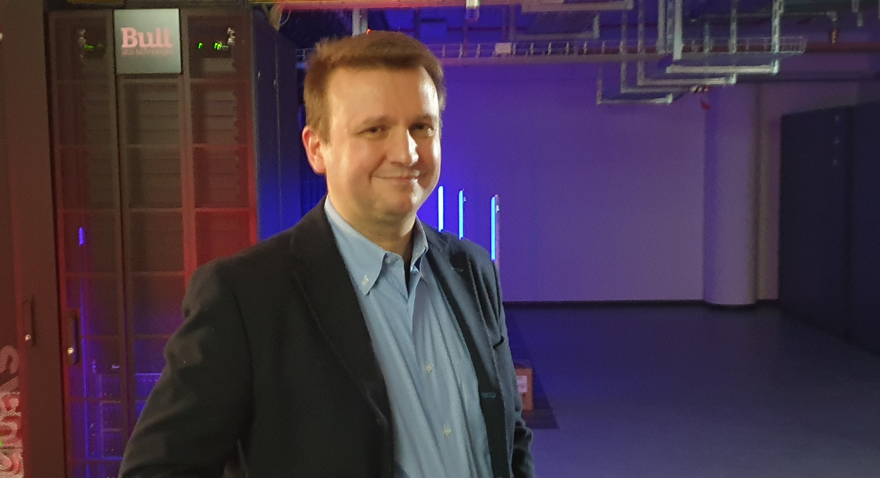Its name brings to mind our very own company name, as well as that of the genius par excellence, the iconic Renaissance artist and inventor, who revolutionised both figurative art and the history of thinking and science. Officially unveiled on 1 December as part of the inauguration of the national competence Hub dedicated to industrial digitisation, davinci-1 is Leonardo’s supercomputer and it is a little like our artificial brain. Or rather: a superbrain. Installed in Genoa at the company site in Torre Fiumara and created with the technical partnership of Atos, a leading name in the world of IT, it is in fact capable of carrying out more than 5 trillion operations per second! This computation power is comparable to that of ten thousand latest-generation PCs, ranking davinci-1 among the top 150 processors in the world and third place (after Japan Aerospace Agency and NASA) among those operating in the aerospace, defence and security sector.
(Italian Version Only)
Specifically, our supercomputer is fitted with a battery of over 150 computation units, each one connected to the others by a high-performance network where each connection has a bandwidth of 100Gbits/second (tantamount to a thousand broad band connections). Moreover, a high-performance storage subsystem guarantees a storage capacity of 20 million Gigabytes, with a read and write speed of 100Gbytes/sec, capable of reading and writing the equivalent to 20 DVDs per second.
Installed in late 2020 and introduced into standard production following a necessary testing and tuning phase in March this year, davinci-1 is the nerve centre of the Genoa HQ of Leonardo Labs, the Group’s laboratories dedicated to innovation, advanced research and to developing the technologies of the future. Their creation constitutes the achievement of one of the growth processes outlined in the strategic plan: “Be Tomorrow - Leonardo 2030”, and is an important step in our digitisation process.

But what exactly is a supercomputer? What does it do and what applications is davinci-1 used for? Carlo Cavazzoni, Head of Computational R&D and Director of the Leonardo HPC Lab answers these questions.
A supercomputer is an integrated set of hardware and software designed to minimise the physical limitations which prevent applications from running instantly rather than taking an indefinite amount of time. These limitations are: computation power, the amount of memory and the I/O band (data transmission speed). All this has to be designed to achieve a machine with well-balanced characteristics, according to the objectives of reducing computation times that may differ according to the various usage environments. That’s why, in order to have greater flexibility in supporting the computer intensive activities of CAE (Computer Aided Engineering: the use of software to solve engineering problems via numerical calculations) as well as the data intensive activities of the world of Big Data, it was also beneficial for us to implement a Cloud service.
Combining Cloud and HPC (High Performance Computing) is not commonplace because it requires the machine to be appropriately designed and managed via a double “brain” (management nodes), one for the supercomputing and one for the cloud, without the two parts coming into conflict. In this regard, davinci-1 is one of the first computers in history to give rise to an accelerated computing system, which the major cloud service providers are also beginning to implement (Microsoft, for instance).
Regarding the usage areas, our supercomputer was designed to support digital transformation processes, the sphere of CAE, Research and Development as well as innovation as a whole, and it is currently implemented both in projects concerning these fields as well as to support our in-house engineering.
Basically, davinci-1 was conceived to generate top performance in developing digital twins (virtual equivalents of physical products), big data processing systems and artificial intelligence algorithms. Specifically, we are bolstering several Leonardo codes used to design helicopters, aircraft and radars, in order to minimise simulation times (from days to hours) and increase the accuracy itself of such simulations.
As for the world of big data, davinci-1 is supporting the honing of Leonardo solutions for the establishment of data lakes, which in other words are repositories that allow the storage of huge quantities of data from multiple sources. To date, the first development phase of the data lake for the Helicopter Division has been completed, and the establishment of a data lake for the Aircraft Division is currently under way.
Where artificial intelligence is concerned, davinci-1 is supporting the training of networks for predictive maintenance, image recognition from both video and satellite, natural language recognition and weather forecast processing.
All the activities described are conducted thanks to the team at the Cloud Computing unit and researchers from the Leonardo Lab in Torre Fiumara, who work with their colleagues at the Labs in the Divisions and the engineers in charge of the company’s various programmes. What’s more, our researchers are carrying out a major technological scouting activity to acquire greater expertise with key innovations for competitiveness, including for instance quantum computing, an area in which we are already engaged. Among the activities currently under way is the testing of next-generation hardware, which is not yet on the market, obtained thanks to agreements with the biggest names in the industry (Intel, Nvidia and AMD), and also - as regards software - the assessment of new programming paradigms, development environments and open source solutions.

